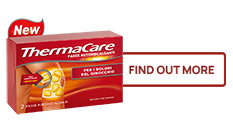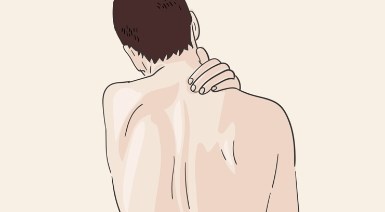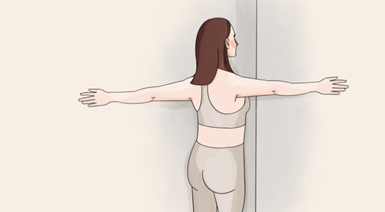What helps relieve tension-related neck pain?

Contents:
An unfavourable posture, using the wrong pillow, a cold draught – all these can lead to tension in the neck. Psychological reasons such as stress, anxiety or sleep disorders often exacerbate the symptoms. Those affected know: Neck pain is often very uncomfortable because it can radiate into the head, where it leads to tension headaches, or into the shoulders and arms, which then sometimes lose mobility. In short: When you have neck pain, you want to get rid of it quickly. Here we will show you what you can do to relieve tension-related neck pain – quickly, as well as long-term, or preventively.
Neck pain is a multi-factorial problem. A sedentary lifestyle, psychological reasons like work-related stress or anxiety or sleep disorders could lead to neck pain onset. This kind of pain could also lead to a tension type headache or to shoulder pain, with an objective loss of function. Therefore is recommeded to treat neck pain as quickly as possible. In This section we’ll show you what to do to relieve tension related neck pain, quickly, as well as long-term, ore preventively.
What helps quickly with neck pain?
If acute neck pain occurs due to muscle tension and even leads to tension type headaches or shoulder problems, could be due to neck muscles overuse. That is the right time to take a break, relax and take care of this Problem. Do you swear by household remedies for neck pain or do you prefer to take medication? Here we will tell you which treatment methods can help quickly with these neck complaints and provide rapid pain relief.
Household remedies to relieve neck pain
Heat for neck pain
A traditional household remedy promises quick and drug-free help for acute tension-related neck pain: heat therapy. Heat promotes blood circulation, relieves muscle tension and noticeably relieves pain. The most common methods of heat therapy are local applications such as electric heating pads, hot water bottles or heated cherry stone or millet pads, as well as heat ointments that are used directly on the affected areas. Furthermore, infrared lamps, saunas or hot baths with circulatory or relaxing herbal additives such as rosemary or chamomile oil also help with neck pain.
However, not all heat therapy measures are equally effective. This is because heat therapy requires the correct temperature in order to work deep into the tissue over a longer period of time. ThermaCare® HeatWraps for neck and shoulder have proven to be very effective for tension type neck pain. Here you will find out how you can quickly relieve neck and shoulder pain with heat therapy and which type of heat therapy works best and is suitable for your needs.
2 cm
The ThermaCare® HeatWraps not only increase the temperature on the surface of the skin, but also generate heat in the muscles, to a measured depth of 2 cm.*
ThermaCare penetrates deeply
The ThermaCare® HeatWraps not only increase the temperature on the surface of the skin, but also generate heat in the muscles.*
-
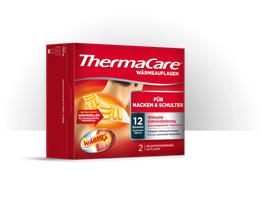
THERMACARE® For neck and shoulder and wrist
for the treatment of neck, shoulder and wrist pain
Massage for neck pain
If a part of the body hurts, people often unconsciously rub it to obtain relief. A back or neck massage helps to loosen muscles and improves blood flow to the tissue. This creates a warm relaxation effect, which can be increased by using warm vegetable oils.
A simple form of self-massage is massage with a device such as a massage or tennis ball or a fascia roller. Sit upright and massage the affected neck and shoulder region with the opposite hand. Change side after two to three minutes.

Of course, a manual therapy treatment made by a physiotherapist has a more intensive effect. There is a number of different massage techniques that range from gently relaxing to deep tissue penetration. Especially in the case of severe and chronic pain, you should find out which treatment your body prefers. In case of structural damage, like a fracture, or in presence of a specific health condition, like ostheoporosis, is recommended the help of a doctor or other health professional.
As a basic rule: In case of severe, chronic or recurrent neck problems associated with joint blockages, medically trained professionals should be consulted. This kind of treatment has less to do with wellness and relaxation, and also usually has a more lasting effect.
Medicinal aid for neck pain
Analgesics for neck pain
Painkillers such as ibuprofen or diclofenac from the group of non-steroidal anti-inflammatory drugs/anti-inflammatory drugs (NSAIDs), which treat pain and inflammation symptomatically, or the analgesic paracetamol, provide quick relief from neck pain. These medications usually bring rapid pain relief, but like any drug they can also cause a number of undesirable side effects and should therefore only be used for a short time and only if tolerated.
What helps against neck pain in the long term and how can it be prevented?
Rapid relief of neck pain is important in order to break the vicious circle and to avoid further Exacerbations. Of course prevention is better . The following methods can help prevent neck pain:
- Exercise to relieve neck pain
-
Active and regular exercise is an important factor in preventing tension-related neck pain. On the one hand, this includes specific exercises for neck . On the other hand, you can also use neck-friendly sports such as swimming on your back, water aerobics, back-friendly yoga, tai-chi, qigong or Nordic walking for stronger muscles and increased blood circulation. And another bonus: Regular exercise leads to an increased natural release of endorphins. This also is important to reduce stress and therefore reduces the physical causes and psychological triggers for neck pain onset equally.
- Tips regarding work-related problems
-
Most tension in the neck region is due to sedentary lifestyle. Many of us spend large parts of the day sitting in front of the computer on the sofa, or in the car. It is therefore no wonder that neck pain is spreading so rapidly among the population. Help your neck and take frequent breaks during work or other concentrated activities to break your sedentary habits: stand up and take a brief walk every 30 minutes. This is not only good for the neck, but also helps to bring a breath of fresh air into tired thoughts.
You can also do relaxation exercises by pulling your shoulders up and down and rolling them back and forth. Tilt your head to the right and left and pull the opposite shoulder down. Enjoy the stretching in the neck muscles. - Choose the right sleeping position and mattress for neck pain
-
Sleep is the time when the body and mind should relax. We spend a correspondingly great deal of time in bed. However, it is often the case that with neck problems, the night’s sleep is no longer restful. If you wake up in the morning with hardened neck muscles, the time has come to optimise your own sleeping position, mattress and pillow.
People with neck pain should, if possible, lie straight and stretched out on their backs and use no or only a very thin pillow. Do you prefer to sleep on your side? Then put a small pillow under your head so that your neck does not bend.
The best sleeping position is on your side, with the pillow which helps neck not to bend.
The following applies to the choice of mattress:- It should support the natural shape of the spine for an optimum positioning of the spine.
- The firmness of the mattress should be adapted to your own sensation. You have to feel comfortable
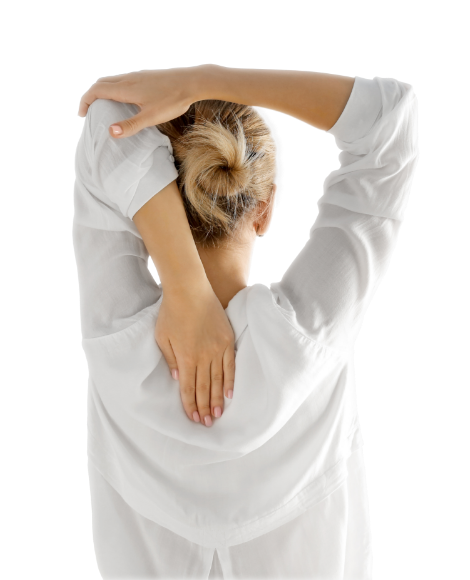
This is how you can relax your neck
You may have noticed that stress makes neck tension worse. And you are right about that: Neck pain can be aggravated by psychological factors such as excessive demands or fear and can lead to stress reactions themselves. As a result of the pain perception, the body tenses and the muscles tense further, which intuitively prompts the body to adopt an unnatural, protective posture in order to avoid further feelings of pain. This creates a vicious circle that makes the symptoms worse and last longer.
In order to reduce or prevent tension-related neck pain, it is therefore worthwhile to relax the neck consciously again and again. Relaxation techniques help, some of which can be applied quickly and easily. Others need practice or instruction. Here we give you an overview of three popular methods:
- Progressive muscle relaxation according to Jacobson: With this method of deep muscle relaxation, individual muscle groups are deliberately tensed and relaxed again for a short time in a specific order. Those who practise this should clearly perceive the before/after state. On one hand, this can help to reduce stress-related tension and contribute to deeper relaxation of the muscles. On the other hand, body awareness can be trained so that, ideally, the person practising this can consciously relax the muscles, for example in the neck, and learn to prevent further tension. This technique is particularly effective for chronic neck pain and less so for acute complaints.
- Meditation: The term meditation covers a large number of techniques, some of which are very different. Whether you sit, walk, prefer guided meditation, focus on breathing or strive for mindfulness – it is usually about focusing the mind regularly in order to gather yourself together and calm down internally, for more awareness and mindfulness. Since meditation can do a lot to reduce the perception of stress, daily practice also helps in the prevention of muscle tension and has a positive effect on the perception of pain.
- Autogenic training: This relaxation procedure is based on autosuggestion. Here, those practising this learn (usually under supervision) to relax their own body using suggestive formulas in combination with rest. This is intended to strengthen the mental posture of those practising this, for example to master pain-related stress self-confidently.
The following applies to all relaxation techniques for the neck: They are always most effective in combination with sufficient exercise and a generally conscious body awareness (for example with regard to one’s own posture).
FREQUENTLY ASKED QUESTIONS
- What helps quickly with neck pain?
-
In the case of painful tension in the neck and shoulder region, depending on the cause, quick heat, for example ThermaCare® HeatWraps for the neck and shoulder, conventional pain relievers and light exercises for muscle stretching and relaxation can help. If neck pain persists or worsens, medical advice should be sought to determine the cause.
- When should neck pain be examined by a doctor?
-
Please seek medical advice for
- Complaints that do not improve within 3 weeks
- recurring pain
- chronic pain
- severe pain
- numbness or tingling in your arms
- dizziness or blurred vision
- muscle weakness
- severe restriction of movementPlease call the emergency doctor immediately in the case of
- neck pain associated with fever, cramps, severe headache, paralysis, or impaired consciousness
- injuries to the cervical spine - What can be done about neck pain in the long term?
-
If the cause of the neck pain is tight muscles, you can:
- exercise regularly (e.g. swimming on your back, water aerobics, back-friendly yoga, tai chi, qigong, Nordic walking)
- exercise the neck muscles with special exercises
- practice relaxation techniques (e.g. meditation, progressive muscle relaxation, autogenic training)
- optimise sleeping position, mattress and pillow - How can neck pain be relieved?
-
Tension-related neck pain can be relieved by the use of heat, painkillers, warming pain ointments, as well as massage and relaxation exercises.
- How long does it take for neck pain to go away?
-
Acute neck pain usually lasts about 1 to 2 weeks. Subacute pain lasts until 4 weeks. If neck pain persists for more than 3 months, it is called chronic neck pain. If neck pain keeps flaring up after pain-free breaks, this is considered as recurrent (recurring) neck pain.
